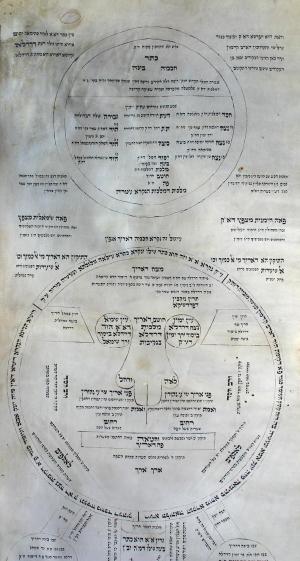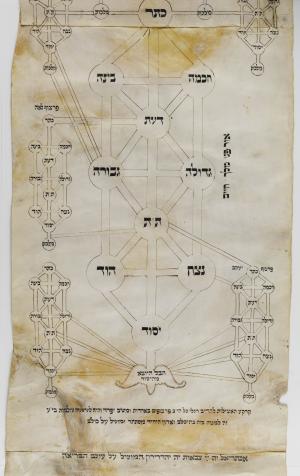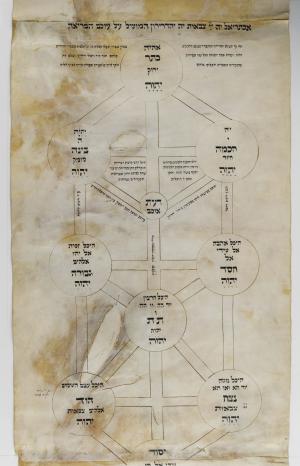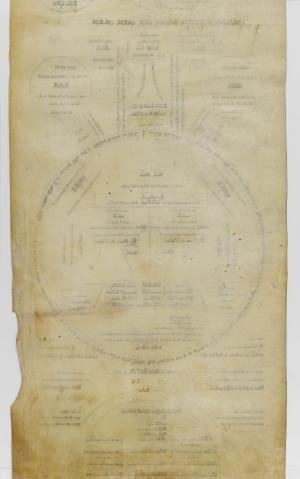Obj. ID: 45434
Hebrew Illuminated Manuscripts Great Tree, Germany, early 18th century

The following description was prepared by William Gross:
Kabbalistic diagrams resembling Porphyrian trees have been known at least since the sixteenth century as “Ilanot” [Heb. pl. Arborae; sing. "Ilan"]. [First such reference known to me is in the work of Guillaume Postel, who refers to "Ilanoth" as a genre of rabbinic literature.] Ilanot constitute visual representations of kabbalistic cosmologies from the relatively simpler forms of the thirteenth century to the far more complex and ramified systems in Lurianic Kabbalah from the sixteenth century onward. The increasing complexity of cosmic trees between the thirteenth and eighteenth centuries directly reflects the exponential ramification of kabbalistic theosophy that took place over those centuries. Given the overwhelmingly visio-spacial conceptions of the divine in its evolutionary “becoming” in these mystical traditions, Ilanot could serve as cosmic maps. This divine cartography aspired to capture the syncronic interrelations between the various facets of the godhead and creation as well as their diachronic, evolving emergence.
What’s an Ilan? Any synoptic diagrammatic presentation of kabbalistic cosmology. The basic graphical forms could range from the arboreal to the boldly anthropomorphic. Lurianic Ilanot, in their lengthy and complex presentations, often feature both, as well as spreadsheet-like tables. The iconic decadal tree is an Ilan, as is the intricately Baroque Hammerschlag Ilan. Diagrams expressing particular concepts within a larger framework, such as the illustrations that frequently accompany certain cosmogonic discussions in the Lurianic corpus, would doubtfully have been called ilanot by anyone. However simple or complex the pictorial-diagrammatic features of an Ilan, extensive textual material is frequently embedded in and around the geometrical forms. The texts may be paraphrastic chapter headings, original compositions, or the study notes of a student. Their connection to the pictorial features alongside which they appear is usually clear, with the text providing a verbal key to the quality or process depicted graphically. That said, in complex Ilanot, simple keying gives way to more complex and even inscrutable connections. Indeed, these manuscripts demand to be treated as “integrated systems of communication” that raise “questions about how verbal and visual patterns of meaning were constructed, combined, and modified.”
Ilan Aroch, the classic Kabbalistic scroll, made by the most serious Kabbalists for their own use as an aid to the study and understanding of the Kabbalistic scheme, particularly the spheres. This very finely written scroll is from East Europe, written on cow skin in six sections sewn together.
Scroll # 17 - 10 frames (028.012.007) 1850ca ? East Europe parchment ink written sewn, 31X384cm [prt. 11; many similarities to # 1]
1. Atika engarmenting A"K, then engarmented by Arikh, to roots of Abba vImma
2. Abba vImma to Yisrael Sabba uTevunah to Keter of Zeir
3. Details of engarmenting from Yisrael Sabba uTevunah to Rachel and Leah; then, recapitulate details of engarment from A"K to Yisrael Sabba uTevunah
4. Cont'd to Zelem of Zeir
5. Diagram of 10 Sefirot encompassing from En-Sof-Arikh to Yesod of Zeir
6. Differentiating the upper Partzufim
7. Differentiating lower Parzufim
8. Beriah [like scroll 12 fr. 12]
9. Yetzirah [to Tiferet - like scroll 12 fr. 13]
10. Entire Yetzirah, ending with Sandalfon - Archangel of Keter of 'Assiah - no Assiah [as is the case in # 1]
sub-set tree:
Chajes, J. H., The Kabbalistic Tree האילן הקבלי, Pennsylvania State University Press 2022., p. 351..














